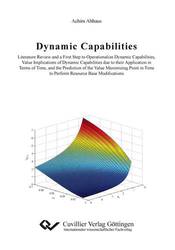| Fachbereiche | |
|---|---|
| Buchreihen (96) |
1379
|
| Nachhaltigkeit |
3
|
| Gesundheitswesen |
1
|
| Geisteswissenschaften |
2367
|
| Medienwissenschaften | 16 |
| Theologie | 57 |
| Philosophie | 102 |
| Rechtswissenschaft | 422 |
| Wirtschaftswissenschaften | 851 |
| Sozialwissenschaften | 416 |
| Sportwissenschaften | 48 |
| Psychologie | 233 |
| Pädagogik | 190 |
| Geschichtswissenschaften | 183 |
| Kunstwissenschaften | 111 |
| Kulturwissenschaften | 166 |
| Literaturwissenschaften | 117 |
| Sprachwissenschaften | 88 |
| Naturwissenschaften |
5407
|
| Ingenieurwissenschaften |
1793
|
| Allgemein |
98
|
|
Leitlinien Unfallchirurgie
5. Auflage bestellen |
|
Erweiterte Suche
Dynamic Capabilities
Literature Review and a First Step to Operationalize Dynamic Capabilities, Value Implications of Dynamic Capabilities due to their Application in Terms of Time, and the Prediction of the Value Maximizing Point in Time to perform Resource Base Modifications
Achim Althaus (Autor)Vorschau
Leseprobe, PDF (63 KB)
Inhaltsverzeichnis, PDF (41 KB)
Dynamic capabilities describe the firms’ capacity to adapt their resources with regard to external shifts in order to maintain or to even enlarge competitive advantage. In this essay the author pursues three research objectives regarding dynamic capabilities. First, based on a literature review the author states that no appropriate dynamic capability concept exists that enables an empirical investigation of dynamic capabilities across industries, however, argues that such an investigation is possible, and outlines a first step to do so. The second research objective is focused on the value of dynamic capabilities. Using real option knowledge the author is able to outline a simple mathematical model. The results show that the value of a firm is not only given by the expected value, generated by the firm’s resources in place, but also by the firm’s options to react to environmental changes. Besides other externally given factors – like market development – the application of dynamic capabilities in terms of time has consequences on the expected firm value. The third research objective deals with the basic challenge of ambidextrous firms to achieve an optimal balance of exploitative and explorative activities with regard to market developments. Again, using real option knowledge the author is able to demonstrate that there exist defined points in time until when to maintain, stress, taper off and finally stop exploitative and explorative activities. A further development of the model even enables the prediction of the value maximizing points in time.
| ISBN-13 (Printausgabe) | 9783954041480 |
| ISBN-13 (E-Book) | 9783736941489 |
| Buchendformat | A5 |
| Sprache | Englisch |
| Seitenanzahl | 192 |
| Umschlagkaschierung | matt |
| Auflage | 1 Aufl. |
| Erscheinungsort | Göttingen |
| Promotionsort | Bern |
| Erscheinungsdatum | 10.07.2012 |
| Allgemeine Einordnung | Dissertation |
| Fachbereiche |
Wirtschaftswissenschaften
|








